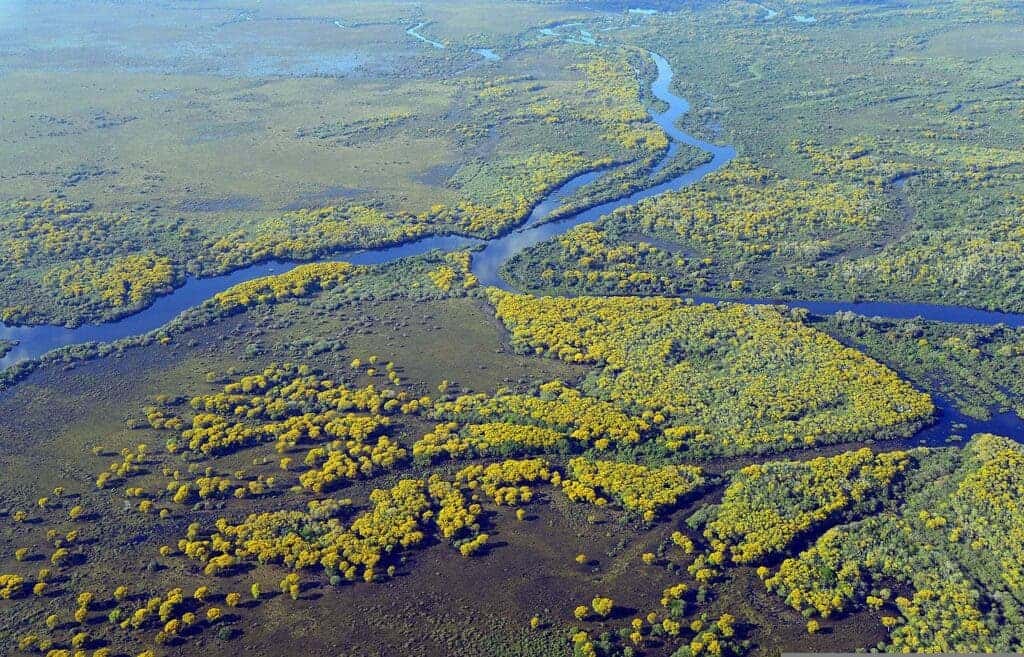Most people have heard of the Amazon, South America’s famous rainforest and a hub of biological diversity. Less well known is the Pantanal, the world’s largest tropical wetland. In an open letter, a group of scientists has warned the wetland is at risk of collapse because of a set of local decisions that don’t consider their impact on nature.

The Pantanal covers an area of over 179,000 square kilometers, more than the state of New York or about as big as two Austrias. It has one of the highest concentrations of flora and fauna in South America, with over 4,700 plant and animal species, some of which are endemic species found only in Pantanal. But the Pantanal is increasingly under threat.
In an open letter, the group of scientists cautions that the wetland was been subject to growing environmental pressure over the past two decades, which threatens the wetland’s long-term survival. The list includes unsustainable infrastructure development, deforestation, waste pollution, and cattle ranching, one of the main economic activities in the area. If current trends continue, the researchers say, the Pantanal may no longer exist in the future.
“There’s still hope for the Pantanal, but its sustainable use must not be challenged by the consequences of small mistaken decisions that fail to consider their cumulative impacts, compromising the future of sustainable cattle ranching, fishing, ecotourism, traditional communities, biodiversity, and ecosystem services,” the scientists wrote.
A concerning trend
Twenty years ago, Dr. Johan Gottgens published an article warning that individual and local interests were detrimental to the collective interest of preserving the Pantanal. Gottgens compared the situation to the “tragedy of the commons” – when individuals act according to their own self-interest and contrary to the common good of everyone.
The classic example of the tragedy of the commons is a situation when farmers share the same crop of land. Every farmer starts out with one sheep, but then they start getting more and more sheep to maximize their own income. But at some point, there are too many sheep for the piece of land they share, the land gets overgrazed, and the whole system just collapses — the individual incentive of the people leads to the collapse of the ecosystem, and everyone’s goods along with it. This is akin to what’s happening in the Pantanal.
Now, two decades later, an interdisciplinary group of Brazilian scientists argues the forecast is becoming a reality. They specifically mention the approval of a growing number of hydroelectric dams in the river basins from the Pantanal wetland, which offer clean, cheap energy to the local population — but also affect the ecosystems in which they are built.
The most recent example is the construction of the Barranco Vermelho port on the Paraguay River, which was approved by the Environment Council of the State of Mato Grosso. The approval considered the local consequences of the project but didn’t address the risks it would pose to the hydrological signature of the Pantanal ecosystems.
In their letter, the researchers argue there’s a synergy among the different threats that affect the Pantanal, which can cause ecological, social, and geographic consequences. Threats to the wetland range from climate change on a global scale to deforestation in the Amazon to severe drought and forest fires – which have killed millions of vertebrates in 2020.
Rafael Morais Chiaravalloti, a scientist who signed the letter, said we are witnessing a “termitization” of the Pantanal, similar to the effects caused by a termite on a piece of wood. Chiaravalloti said “small and widespread” holes are being made on the wetland, which aren’t noticeable by looking from the outside but that are eating the wetland from inside out and are becoming significant enough to pose an existential threat to the Pantanal.
“The Pantanal is an ecosystem where the extension and duration of the seasonal floods are vital to maintaining biodiversity, traditional cattle ranching and resources used by local communities. We are witnessing a convergence of threats that may lead to the disappearance of the Pantanal as we know it today,” scientist Fernando Tortato said in a statement.
The letter was published in the journal BioScience.









